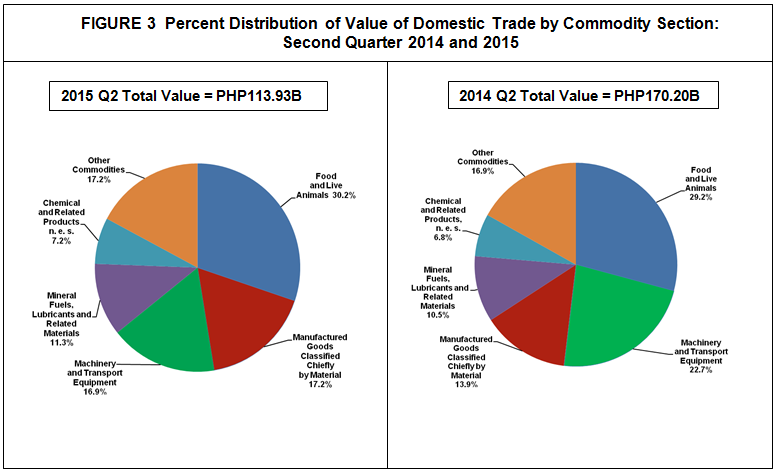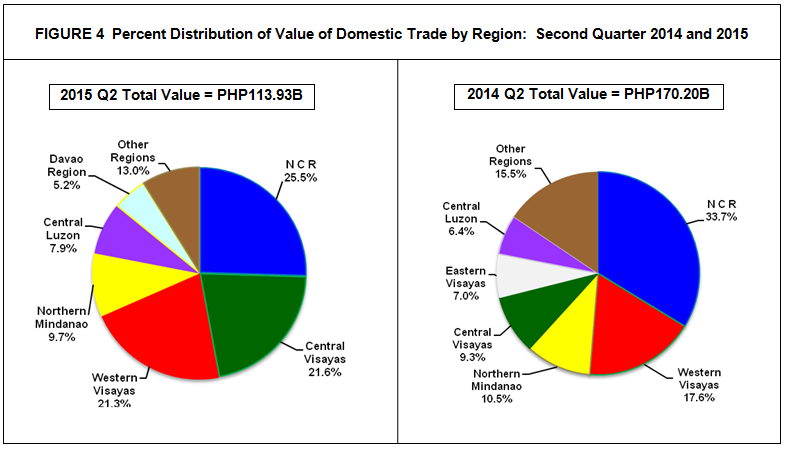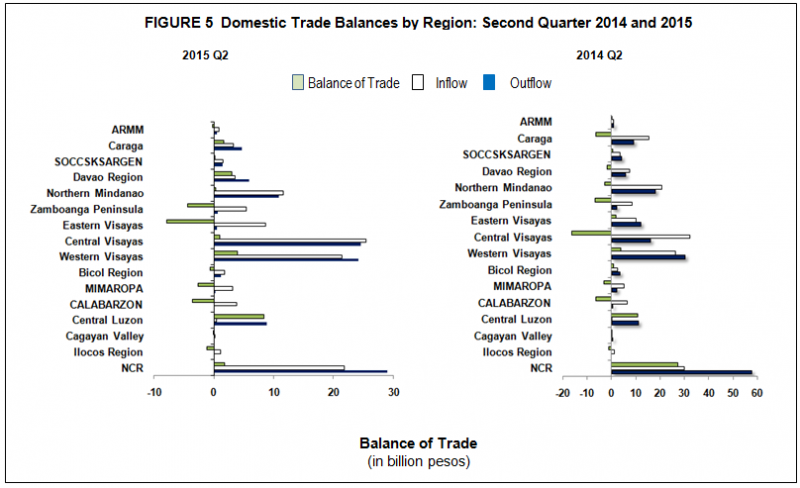Commodity flow or domestic trade refers to the flow of commodities through the water, air and rail transport systems in the country. Data on the inflow and outflow of commodities in the different regions of the country are used to construct interregional and inter-industry relation tables. These serve as bases in the formulation and implementation of various regional development programs like countryside development and port planning.
Similarly, the total value of commodities that flowed within the country decreased by 33.1 percent from PHP170.20 billion in the second quarter of 2014 to PHP113.93 billion in the same period of 2015.

Food and live animals leads total domestic trade value
In the Second quarter of 2015, the bulk of the value of commodities (30.2%) that flowed throughout the country came from food and live animals amounting to PHP34.41 billion. This was followed by manufactured goods classified chiefly by materials with PHP19.58 billion (17.2%) and machinery and transport equipment with PHP19.22 billion (16.9%). Animal and vegetable oils, fats and waxes had the least value of PHP1.37 billion (1.2%).
Food and live animals contributed the largest value in the second quarter of 2014 amounting to PHP49.65 billion (29.2%). Machinery and transport equipment followed next with PHP38.71 billion (22.7%) while manufactured goods classified chiefly by material recorded PHP23.72 billion (13.9%). Animal and vegetable oils, fats and waxes shared the least value of PHP2.14 billion (1.3%). (See Table 1)

National Capital Region leads in the value of domestic trade
National Capital Region (NCR) reported the highest share on domestic trade at 25.5% in the second quarter of 2015. Central Visayas was second 21.6% followed by Western Visayas 21.3% while Northern Mindanao accounted for 9.7%. CALABARZON domestic trade contributed the least share among the regions with only 0.2%. (See Table 2)

Central Luzon leads the highest favorable trade balance
In the second quarter of 2015, Central Luzon posted the most favorable trade balance at PHP8.45 billion. Other regions which had a billion mark positive trade balances were NCR, PHP7.26 billion; Western Visayas, PHP2.82 billion; Davao Region, PHP2.45 billion; and Caraga, PHP1.46 billion. On the other hand, Eastern Visayas suffered an unfavorable trade balance of negative PHP8.05 billion. Other regions with a billion mark negative trade balances were Zamboanga Peninsula, PHP4.64 billion; CALABARZON, PHP3.61 billion; MIMAROPA, PHP2.72 billion; Ilocos Region, PHP1.10 billion; Central Visayas, PHP0.81 million; Bicol, PHP0.62 million; ARMM, PHP0.24 million; and Cagayan Valley, PHP0.08 million. (See Table 4)

Notes:
1. Commodity flow or domestic trade refers to the flow of commodities through the water, air and rail transport systems in the country.
Data on the inflow and outflow of commodities in the different regions of the country are used to construct interregional and inter-industry relation tables. These serve as bases in the formulation and implementation of various regional development programs like countryside development and port planning.
2. DOMSTAT reports from the following provinces/cities were not yet received as of June 15, 2015, thus, were not included in this special release:
|
Province |
Mode of Transport |
Reference Quarter |
|
a. Mindoro Occidental |
Coastwise |
April to June |
|
b. Romblon |
Coastwise |
April to June |
|
c. Zamboanga del Norte |
Coastwise |
April to June |
|
d. Zamboanga del Sur |
Coastwise |
April to June |
|
e. Misamis Occidental |
Coastwise |
April to June |
|
f. Sulu |
Coastwise |
April to June |
3. As of first quarter of 2015, Philippine National Railways (PNR) has no rail transaction.
